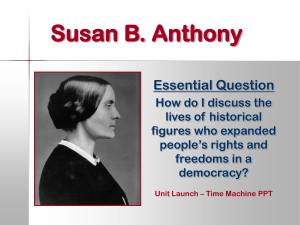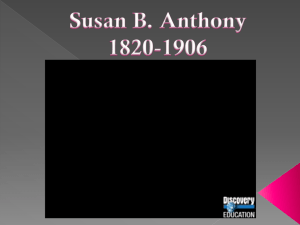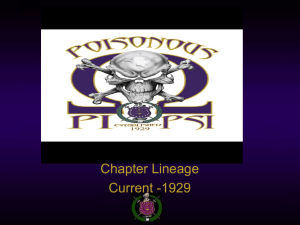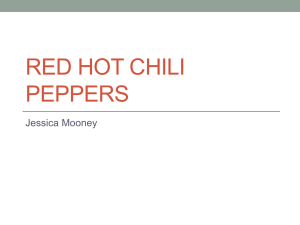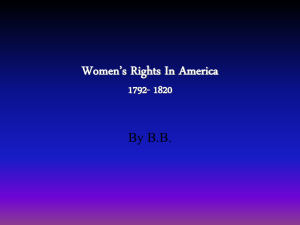Person-Centered Therapy Carl Rogers (1902
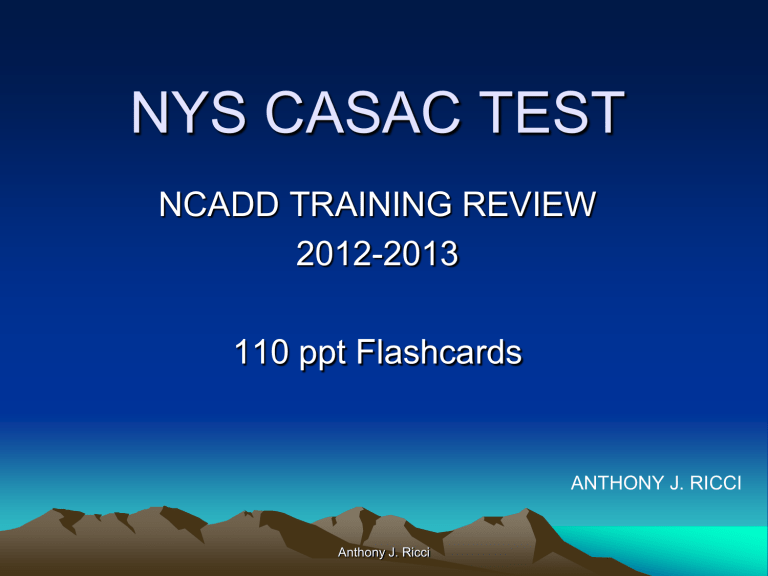
NYS CASAC TEST
NCADD TRAINING REVIEW
2012-2013
110 ppt Flashcards
ANTHONY J. RICCI
Anthony J. Ricci
REVIEW FLASH-CARDS
To get the most out of this study tool, remember to view it as a ppt slide show.
I hope they are helpful, I tried to cover the most basic pertinent info that has historically been known to being on the CASAC test.
By no means is this all the questions or all the answers.
My honest opinion is: if you where, in class and awake. You should have no problem.
NCADD presents a great 2 day CASAC TEST REVIEW CLASS
Will let you know when its scheduled.
Don’t stress, Don’t overthink, Review the basics.
Best !
Anthony
May 11, 2013
P.S. Questions get answers, in your last few weeks with us, PLEASE approach
Dennis, Jim, or myself with your questions, concerns, etc. We are here for YOU !
Anthony J. Ricci
group therapy
type of therapy in which a group of clients meet together with a therapist. psychotherapy where multiple people meet regularly to interact and help one another to achieve insight into their feelings and behavior; allows the therapist to see how the client interacts with others, offers a social support, and shows the client that s/he is not the only person with that problem
Anthony J. Ricci
Assessment
an ongoing process through which the counselor collaborates with the client and others to gather and interpret information necessary for planning treatment and evaluating client progress.
Anthony J. Ricci
Central Nervous System
One of the major divisions of the nervous system, composed of the brain and spinal cord.
Anthony J. Ricci
arbitrary inference
distortion of thinking in which a person draws a conclusion that is not based on any evidence
Anthony J. Ricci
cognitive therapy
therapy in which the focus is on helping clients recognize distortions in their thinking and replace distorted, unrealistic beliefs with more realistic, helpful thoughts
Anthony J. Ricci
Frontal Cortex
Cortical region essential for information processing
Anthony J. Ricci
fritz perls
1893-1970. developed and popularized gestalt therapy
Anthony J. Ricci
LGBTQ
An acronym for
L esbian, G ay (male), B isexual,
T ransgender and persons Q uestioning their sexual identity
Anthony J. Ricci
therapy
treatment methods aimed at making people feel better and function more effectively
Anthony J. Ricci
antianxiety drugs
drugs used to treat and calm anxiety reactions, typically minor tranquilizers.
Anthony J. Ricci
Blood Brain Barrier
Selective filtering between the cerebral blood vessels and the brain
Anthony J. Ricci
sigmund freud
1856-1939. founder of the psychoanalytic school of thought which focuses on the role of the unconscious on behavior
Anthony J. Ricci
family counseling
a form of group therapy in which family members meet together with a counselor or therapist to resolve problems that affect the entire family
Anthony J. Ricci
Neurons
Specialized nerve cells that make up the nervous system and release neurotransmitters
Anthony J. Ricci
Post Traumatic Stress
Disorder (PTSD)
A psychiatric syndrome in which an individual who has been exposed to a traumatic vent or situation experiences persistent psychological re experiencing the trauma, numbing of general responsiveness, and hyperarousal
Anthony J. Ricci
Synapse
Site of communication between a message sending neuron and its message receiving target cell
Anthony J. Ricci
Mental Set
The collection of psychological and environment factors that influence and individuals response to drug
Anthony J. Ricci
Beck's Cognitive Therapy
cognitive technique; designed by Aaron Beck; designed to identify and change inappropriate negative and self-critical patterns of thought; primarily used to treat depression, anxiety and substance abuse; therapy is not as challenging and confrontational as REBT; aims to lead person to more realistic and flexible ways of thinking
Anthony J. Ricci
Culturally sensitive counseling
The first step is to be aware of one's own lack of information about other's cultures and one's own prejudices.
Anthony J. Ricci
Rebound Effect
Form of withdrawal; paradoxical effect that occur when a drug has been eliminated front the body
Anthony J. Ricci
THE 4 GOALS for clients of GROUP THERAPY
Change in Thinking
New ways to define their problems and figure out solutions.
Change in Feeling
Identify and change the emotions they experience.
Change in Actions
Do something different to try and solve their problems.
Change in Relating
Ways to involve other people in personal problem solving.
Anthony J. Ricci
Social
Lubricant
Belief that drinking (misconceived as safe) represses inhibitions, strengthens extroversion, and leased to increased sociability
Anthony J. Ricci
Behavioral Tolerance
Compensation for motor impairments through behavioral pattern modification by chronic alcohol users.
Anthony J. Ricci
Delirium Tremens (DTs)
The most severe, even life threatening form of alcohol withdrawal, involving hallucinations, delirium, and fever
Anthony J. Ricci
Blood Alcohol
Concentration (BCA)
Concentration of alcohol found in the blood, often expressed as a percentage
Anthony J. Ricci
Codependency
Behavior displayed by either addicted or no addicted family member (codependents) who identify with the alcohol addict and cover up the excessive drinking behavior, allowing it to continue and letting it affect the codependents life
Anthony J. Ricci
Autonomy
Respect the client's independence and self-determination
Anthony J. Ricci
cognitive behavioral therapy (cbt)
action therapy in which the goal is to help clients overcome problems by learning to think more rationally and logically
Anthony J. Ricci
CAGE
Four questions - yes to one indicates the possibility of alcohol dependence. Cut down? Annoyed by criticism of drinking behavior? Guilty about drinking? Eyeopener?
Anthony J. Ricci
Rational-Emotive Therapy
(RET)
cognitive therapy founded by Albert Ellis; directive therapy; based on the idea that psychological distress is caused by irrational and self-defeating beliefs; therapy is designed to challenge the dysfunctional thoughts
("stinking thinking") and reinterpret the thoughts in a more positive light; therapy is challenging and confrontational; aims to lead person to more realistic and flexible ways of thinkin g
Anthony J. Ricci
HIPAA ?
The Health Insurance Portability and Accountability Act
This federal regulation protects client rights by covering all personal health information that can be used to identify an individual.
Anthony J. Ricci
42 CFR
This federal law prohibits counselors from divulging the fact that someone is in treatment or any details of their treatment without the client's written consent, when the client is in a clear state of mind. Applies to former and deceased clients also.
Anthony J. Ricci
Instances when confidentiality may be broken
Sharing among staff of a program, reporting child abuse or neglect, threatening to harm another person, threatening suicide, committing or threatening a crime on program property or against program staff, medical emergencies, elder abuse and court orders
.
Anthony J. Ricci
free association
freudian technique in which a patient was encouraged to talk about anything that came to mind without fear of negative evaluations
Anthony J. Ricci
Ethics
The rules of conduct recognized in a particular profession, the shared standards of what is good practice.
Anthony J. Ricci
eclectic therapies
therapy style that results from combining elements of several different therapy techniques
Anthony J. Ricci
Race
A socio-political concept. Not biological.
Anthony J. Ricci
carl rogers
1902-1987. humanist psychologist who focused on the role of the self-concept and positive regard on personality development
Anthony J. Ricci
Detoxification
Detoxification is a process in which the body is allowed to free itself of a drug.
This period, the symptoms of withdrawal are treated.
Detoxification is the primary step in any drug treatment program, and is used as the initial phase in treating alcohol, heroin, inhalant, sedative, and hypnotic addictions
.
Anthony J. Ricci
Informed Consent and
Releases of Information
Includes, but is not limited to, the purpose of the disclosure, the person to receive the disclosed information, and the date or condition under which the consent will expire.
Anthony J. Ricci
person-centered therapy
a nondirective insight therapy based on the work of carl rogers in which the client does all the talking and the therapist listens
Anthony J. Ricci
Duty to warn
This refers to a counselor's responsibility to alert the appropriate authorities of a threat .
Anthony J. Ricci
Key concept about diversity
Within-group differences are always greater than betweengroup differences.
Anthony J. Ricci
Mood
A sustained emotion. Changes less frequently than affect.
Anthony J. Ricci
Professional Development
An ongoing responsibility accomplished through engaging in continuing education, selfevaluation, supervision and consultation
Anthony J. Ricci
Advocacy
Any activity designed to obtain a service, practical help, support or information for a client.
Anthony J. Ricci
three approaches to counseling
Directive
Non-directive
Combined
Anthony J. Ricci
humanistic therapy
psychotherapy focused on conscious, subjective experiences of emotion and people's sense of self
Anthony J. Ricci
Supervision
The purpose of this is to promote the counselor's growth, protect the welfare of clients, monitor counselor performance and empower the counselor to selfsupervise and carry out responsibilities as an independent professional.
Anthony J. Ricci
transference
in psychoanalysis, the tendency for a patient or client to project positive or negative feelings for important people from the past onto the therapist
Anthony J. Ricci
Fetal Alcohol Syndrome
(FAS)
A condition affecting children born to alcohol consuming mothers that is characterized by facial deformities, growth deficiency, and mental retardation
Anthony J. Ricci
Evidence-Based
Practices
Interventions that show consistent scientific evidence of being related to preferred client outcomes.
Most definitions include three components:
Clinical expertise
Patient preferences
Research-based information
Anthony J. Ricci
therapeutic alliance
the relationship between therapist and client that develops as a warm, caring, accepting relationship characterized by empathy, mutual respect and understanding
Anthony J. Ricci
psychoanalysis
an insight therapy based on the theory of freud, emphasizing the revealing of unconscious conflicts
Anthony J. Ricci
Wernicke-Korsakoff's
Syndrome
Psychotic condition connected with heavy alcohol use and associated vitamin deficiencies
(wet-brain)
Anthony J. Ricci
contemplation stage
a stage of change in which the individual is aware that a problem exists and is thinking about overcoming it but has not yet made a commitment to take action.
Anthony J. Ricci
gestalt therapy
form of directive insight therapy in which the therapist helps the client to accept all parts of his or her feelings and subjective experiences, using leading questions and planned experiences such as role-playing
Anthony J. Ricci
Goal Statement
Component of a Treatment Plan that should be acceptable to the client and answers the question, "What is necessary to remedy the problem?"
Should be stated positively - eg. "Client will maintain abstinence," rather than,
"Client will not drink."
Anthony J. Ricci
nondirective therapy
therapy in which the therapist remains relatively neutral and does not interpret or take direct actions with regard to the client, instead remaining a calm, nonjudging listener while the client talks
Anthony J. Ricci
Social factors
These include poverty, oppression, poorly developed social skills, and family dysfunction that may contribute to a client's causes of substance abuse and dependence.
Anthony J. Ricci
self-help groups (support groups)
a group composed of people who have similar problems and who meet together without a therapist or counselor for the purpose of discussion, problem solving, and social and emotional support
Anthony J. Ricci
unconditional positive regard
referring to the warmth, respect, and accepting atmosphere created by the therapist for the client-centered therapy
Anthony J. Ricci
Four emphases of supervision
Administrative,
Evaluative, Clinical and Supportive
Anthony J. Ricci
Referral
Counselors need to be able to recognize symptoms in clients that require assessment by other professionals and be familiar with services available.
Anthony J. Ricci
Axis V
This axis of the DSM IV -TR is the
Global Assessment of Functioning
(GAF) scale, which assigns a number from 1 to 100 to the counselor's judgment of the client's overall level of psychological, social and occupational functioning.
Anthony J. Ricci
Strategies
Component of a Treatment Plan that states what the counselor will do to help meet the client's objectives.
Includes the theoretical model to be used, (eg. reality therapy) and the specific techniques to be employed
(eg. assertiveness training or refusal skills training). These are sometimes also called "Interventions".
Anthony J. Ricci
preparation stage
A stage of change in which the individual seriously considers taking action to overcome a problem in the next thirty days and has unsuccessfully taken action over the past twelve months.
Anthony J. Ricci
barriers to counseling
1. personal bias
2.race/age
3. recovery experience
4.setting
Anthony J. Ricci
Delusions
False beliefs that are maintained despite proof against their truth.
Anthony J. Ricci
Action stage
Action stage of change in which the individual actually modifies his or her behavior and environment in order to overcome a problem. n stage
Anthony J. Ricci
Homophobia
(Homophobic) The fear and hatred of, or discomfort with, people who love and are attracted to members of the same sex
Anthony J. Ricci
precontemplation stage
A stage of change in which the individual may wish to change but either lacks the serious intention to undergo change in the foreseeable future or is unaware of how significant his or her problem has become.
Anthony J. Ricci
biopsychosocial model
A perspective on drug-abuse treatment that recognizes the biological, psychological, and social factors underlying drugtaking behavior and encourages an integrated approach, based upon these factors, in designing an individual's treatment program.
Anthony J. Ricci
Biological factors
These include brain chemistry problems, which may be genetic, making some people particularly vulnerable to addiction to certain drugs once they try them.
Anthony J. Ricci
maintenance stage
A stage of change in which the individual has become drug free for a minimum of six months and has developed new skills and strategies that reduce the probability of relapse.
Anthony J. Ricci
The Person-Centered
Approach
Assumes that clients can be trusted to select their own therapists, to choose the frequency and length of their therapy, to talk or to be silent, to decide what needs to be explored, to achieve their own insights, and to be the architects of their own lives.
Anthony J. Ricci
DSM-IV-TR
Diagnostic and Statistical Manual of Mental Disorders, Fourth
Edition, Text Revision (APA,
2000).
DSM-V-TR May 2013
Anthony J. Ricci
Biopsychosocial perspective
This recognizes that there are biological, psychological and social causes of substance abuse and dependence
Anthony J. Ricci
Psychological factors
These include cognitive styles, personality traits, and early developmental experiences that may contribute to a client's causes of substance abuse and dependence.
Anthony J. Ricci
Motivational interviewing
This is a style of interacting with clients, used not only for assessment, but for all phases of treatment, that is particularly helpful for reducing defensiveness and encouraging therapeutic collaboration between the counselor and client.
Uses the interpersonal process to enhance clients' motivation to change, and encourages clients to move on to the next stage of readiness for change.
Anthony J. Ricci
MAST
Michigan Alcoholism Screening
Test - yes or no to 25 questions.
Anthony J. Ricci
Axis I
Contains 16 categories of clinical disorders, one of which is
Substance Related Disorders.
Anthony J. Ricci
AUDIT (Alcohol Use Disorders
Identification Test)
The 10 items on this instrument developed by the World Health Organization ask about frequency of drinking, alcohol dependence, and problems caused by alcohol. Scores range from 0 to 40 with a score of 8 or higher indicating the likelihood of harmful alcohol consumption.
Anthony J. Ricci
Cluster B
Axis II disorders that often co-occur with substance abuse and dependence, and are characterized by dramatic, emotional, erratic, or impulsive behavior, or a reduced capacity for empathy. They include Antisocial
Personality Disorder, Borderline Personality
Disorder, Histrionic Personality Disorder and
Narcissistic Personality Disorder.
Anthony J. Ricci
The Client’s Experience in Therapy
• 1. Experiencing responsibility.
• 2. Experiencing the therapist.
• 3. Experiencing the process of exploration.
• 4. Experiencing the self.
• 5. Experiencing change.
Anthony J. Ricci
Substance Related
Disorders
This category of clinical disorders in Axis I of the DSM IV-TR includes both Substance Use
Disorders and Substance Induced
Disorders.
Anthony J. Ricci
Substance Use Disorders
This sub-category of Substance
Related Disorders includes both
Substance Abuse and Substance
Dependence.
Anthony J. Ricci
Substance Induced Disorders
These Axis I disorders are a subcategory of Substance Related
Disorders and can include Substance
Intoxication and Substance
Withdrawal, Substance induced delirium, persisting dementia, persisting amnesic disorder, psychotic disorder, mood disorder, anxiety disorder, sexual dysfunction disorder, and sleep disorder.
Anthony J. Ricci
Axis II
This axis of the DSM IV- TR includes the personality disorders as well as mental retardation.
Anthony J. Ricci
Borderline Personality
Disorder
This personality disorder features a pervasive pattern of instability in interpersonal relationships, self-image, affect, and control over impulses. Features may include frantic attempts to avoid real or imagined abandonment, impulsivity in at least two areas that are self-damaging, chronic feelings of emptiness.
Anthony J. Ricci
Cluster A
Axis II disorders that feature odd, eccentric, isolative, or suspicious behavior. They include Paranoid,
Schizoid, and Schizotypal personality disorders.
Anthony J. Ricci
Substance Dependence
A maladaptive pattern of substance use, leading to clinically significant impairment or distress, as manifested by 3 or more of the following 7 criteria: tolerance, withdrawal, increased dose or dosing for longer periods of time, attempts to cut down unsuccessfully, time spent obtaining, using, recovering from use, important social, occupational and recreational activities given up or reduced because of use, physical or psychological problems caused or exacerbated by continued use.
Anthony J. Ricci
Person-Centered Goals in Therapy
• Become more self-directed.
• Increase positive self-regard.
• The client chooses the goals.
Anthony J. Ricci
Antisocial Personality
Disorder
This personality disorder features a pervasive pattern of disregard for and violation of the rights of others.
Anthony J. Ricci
Illusions
Misperceptions of actual sensory input.
Anthony J. Ricci
Axis IV
This axis of the DSM IV - TR contains nine psychosocial and environmental problems that may affect the client's diagnosis, treatment and prognosis, including primary support group, social environment, educational, occupational, housing , economic, healthcare access, legal system/criminal, and other.
Anthony J. Ricci
Physiological
Dependence
Indicated by whether tolerance and withdrawal are present
Anthony J. Ricci
Substance Abuse
A maladaptive pattern of substance use leading to clinically significant impairment or distress, as manifested by at least one of the four following criteria occurring within a 12- month period: recurrent substance use resulting in a failure to fulfill major obligations at home, school or work, recurrent substance use in situations in which it is physically hazardous, recurrent substance use legal problems, and continued substance use despite having persistent or recurring problems caused or exacerbated by the effects of the substance.
Anthony J. Ricci
Tolerance
Defined by either a need for markedly increased amounts of the substance to achieve intoxication or desired effect or markedly diminished effect with continued use of the same amount of the substance.
Anthony J. Ricci
Withdrawal
Defined by either the characteristic withdrawal syndrome for the substance or the same or a closely related substance being taken to relieve or avoid withdrawal symptoms.
Anthony J. Ricci
Dually-Diagnosed
CO-OCCURING
This client has one or more other psychiatric disorders along with substance abuse or substance dependence. Also known as cooccurring disorders. All disorders should be treated concurrently and aggressively
Anthony J. Ricci
Specifies
Used for Substance Dependence
Diagnosis, these six categories are: Early full remission, early partial remission, sustained full remission, sustained partial remission, on agonist therapy, in a controlled environment.
Anthony J. Ricci
Polysubstance
Dependence
The proper diagnosis for a client who has repeatedly taken at least three groups of substances, and who meets criteria for dependence for the substances as a group, but not for the substances individually
Anthony J. Ricci
Hallucinations
Perceiving something in the absence of a sensory input. May be auditory, visual, olfactory, gustatory or tactile
Anthony J. Ricci
Problem Statement
Component of a Treatment Plan that should be stated in client's words whenever possible.
Answers the question, "Why are you here?" Include statement of problem and evidence for it.
Anthony J. Ricci
TX Objectives
Component of a Treatment Plan that states specific things the client will do to meet the goal.
Stated in behavioral terms, and are observable, realistic, time specific, appropriate to the level of treatment and measurable.
Anthony J. Ricci
Affect
The external expression of an internal emotional state.
Anthony J. Ricci
FYI: Axis I, IV and V
CASACs are responsible for these three axes on the Written
Assessment Summary. Other axes can be written up as
"deferred" or list symptoms eg. deferred, reports frequent headaches.
Anthony J. Ricci

